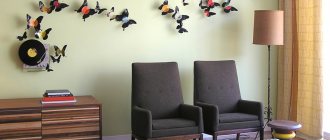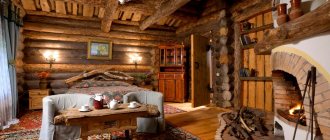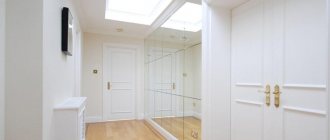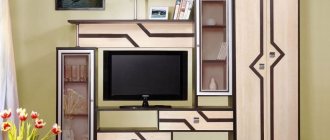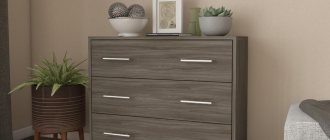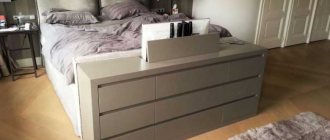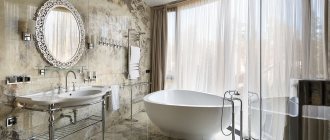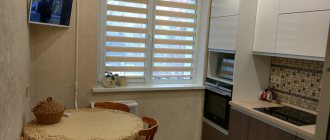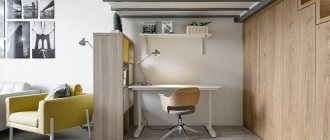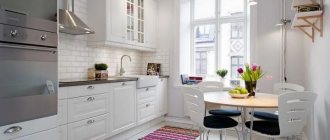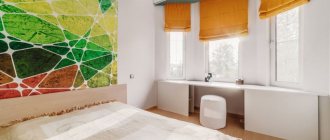In a modern interior, TV is not only one of the ways of evening leisure. Over the past couple of decades, its role has changed dramatically. Now it is not just a mandatory element of the interior, but one of the main components of the design. In some homes, TV even occupies a dominant position. For example, in a room with a home theater. Here, the selection and arrangement of furniture and interior decoration are carried out in such a way as to ensure the highest quality sound and picture on the screen.
Recommendations for placing the TV in the interior
Tips for placing the TV panel:
- The optimal distance from the viewer to the TV device is 3-4 screen diagonals, for example, if the plasma is 20 inches, then it should be viewed from a distance of 1.5-2 meters.
- It is not recommended to place the TV in front of a window, as light glare may interfere with viewing.
- In a narrow room, when placing the TV on the side walls, you should not choose oversized models with a large diagonal.
At what height should I place it?
An acceptable height for placement is 1 meter from the floor plane. You should also take into account that the center of the television screen is at eye level, for this you need to adhere to the height of the furniture, such as armchairs, a sofa or a bed.
TV on the wall: basic placement rules
Add space to the room by freeing it from a TV stand or bulky stands. Of course, hanging a TV on the wall is not as easy as hanging a picture or a mirror. First of all, you need to decide on a place and arrange it correctly. Main criteria:
installation height. The ideal option is for the center of the TV to be located exactly opposite the viewer’s eye level. Therefore, it is also important to consider the height of the sofa and armchairs;
wall material . The weight of the TV is not light, and a regular plasterboard wall simply cannot support 30 kg. Therefore, it is best to mount the bracket on a brick or concrete wall. Even at the planning stage, you need to determine a place for the TV on the wall, which is then further strengthened (with mortgages, thick plywood), and in the case of drywall, you need to use special dowels.
gap r . There should be a small gap (at least 10 cm) on all sides of the TV. This is necessary for ventilation and cooling of the TV.
heating . Try to avoid heat. The TV should not be placed in direct sunlight or near heating devices.
Before deciding where the TV will be located, you must immediately determine what other equipment will be connected (speakers, game console, Internet, cable TV, DVD player). Here you will need to install the required number of sockets, as well as think about the hidden placement of cables.
Ideas for decorating the area behind the TV
Original design ideas for the TV area.
Brick wall
Brickwork or its imitation, thanks to its lively and attractive texture, will never look banal. With the help of this design, it is possible to beat the TV zone in the most original and effective way.
Flowers
This design will add extraordinary color to the room and bring liveliness, freshness and comfort to the atmosphere.
Photo wallpaper
Photographic canvases with clear, detailed images are not only an excellent design tool, but they also represent a very high-quality and beautiful finishing material with which you can bring to life any of your most daring decorative ideas.
Made of wood
Wooden wall decoration, thanks to its amazing ability to attract attention, allows you to fill the space with special energy, warmth, peace and inspiration.
Laminate
It is considered an excellent solution for creating an original interior composition. If you show a certain amount of imagination, you can design the TV area in a particularly impressive way.
Panel
With the help of such a unique decorative product, you can add variety and personality to the TV wall.
Decorative rock
Decorative stonework personifies beauty and reliability and, due to its natural appearance, undoubtedly becomes the most noticeable element of the interior.
The photo shows the interior of the living room and TV area with a fireplace, lined with decorative stonework.
Backlight
Thanks to the different intensity, color and light spectrum of the backlight, it is possible to emphasize the TV area and enhance the impression of the overall decor.
Rear panels
They allow you to create an extraordinary three-dimensional design of the TV area, which will impress any imagination with its appearance.
The photo shows the interior of a children's room with a small TV located on the wall with a white 3D panel.
Shelves
Beautiful and original wall shelves allow you to create additional horizontal planes that can easily be filled with a variety of necessary items, such as books, photographs, figurines or souvenirs.
Installation Features
When installing a TV, certain rules should be taken into account:
- Wire insulation . Before installing the TV, aesthetic design is ensured. Wires and connecting cables must be insulated. Not only do they look unsightly, but they can also be harmful to children or pets.
- Choice of fastening. The weight of new TV models is up to 40 kg. However, you still need to choose a reliable bracket for mounting, and also check the strength of the wall.
- Selection of brackets. Universal (adjustable) brackets are in greatest demand. These devices are not cheap, but they allow you to change the tilt of the TV and rotate it in different directions.
Installing the TV is carried out in the following order. First, markings are made to attach the bracket. Holes are drilled with a drill and the bracket is placed in them. Next, the TV receiver is fixed. It is usually equipped with connectors for mounting. It is necessary to fix the TV and determine the appropriate angle of inclination. It is advisable to install the TV together with an assistant.
Human comfort and health depend on the correct installation of the TV. Both the height from the floor and the distance between the viewer and the TV receiver should be taken into account. Incorrect installation of the TV panel puts stress on the eyes, muscles and joints. It is recommended to watch TV up to 2-3 hours a day for adults, up to 1.5 hours for teenagers and up to 15-20 minutes for preschoolers.
- How to choose a TV for the interior of the room
- How to neatly hide wires from your TV
© — when copying materials, an active link to the site is required!
TV location
Popular options for placing a TV panel.
In the corner
With the help of this arrangement, it turns out not only to make maximum functional use of the corner space, but also to rationalize and optimize a small room.
The photo shows a modern bedroom and a plasma TV with a corner wall placement.
Near the window
The space near the window opening or the partition between the windows can be easily turned into a TV area that will not take up much usable space.
In a plasterboard niche
A regular plasterboard niche or recess, complemented by built-in lighting or highlighted with a contrasting color of wallpaper or other finishing, allows you to focus attention on the TV area and conveniently hide television wires, antenna and cables.
The photo shows a TV placed in a plasterboard niche in the interior of a children's room.
On a false wall
These designs are used for functional zoning of space in the studio, so the placement of TV primarily depends not only on the designer’s imagination, but also on the layout of the entire room.
The photo shows a plasma TV on a sloping wall that acts as a partition.
Built into furniture
Modular furniture systems provide an optimal and very practical solution for integrating various equipment, including television.
The photo shows a living room and a brown modular wardrobe with a built-in plasma TV.
Arch
The rounded arched shape, with or without built-in lights, frames the TV device, accentuates it and gives the wall an original and stylish look.
Installation tips from experts
As for hanging a TV receiver in a children's room or living room, where programs can be viewed from different angles, you can adjust the tilt, rotation and even height using appropriate brackets, which come in several types:
- inclined – adjustable vertically;
- tilt-rotary – changes position vertically and horizontally;
- fixed - is the most durable and cheapest option;
- movable – adjusts the location of the television receiver in space in almost any direction, including height;
- ceiling - attached to the ceiling.
The fastening process itself is not particularly difficult. You need to mark the holes on the wall with a pencil (taking into account the above recommendations), paying special attention to the horizontal level. Next, holes are drilled along the markings into which dowel screws are inserted, and one part of the bracket is attached to them. While the other is bolted to the television receiver. Then both components of the fastener are connected (the guides are inserted into the corresponding grooves).
Important! Even a slight misalignment of the bracket over time leads to the fall of the television panel. Therefore, you need to carefully mark the attachment points using a level.
But the success of the process of hanging a TV receiver largely depends on the material of the wall. So, experienced craftsmen give the following advice on this matter.
- When hanging on a plasterboard wall, it is necessary to cut exclusively into the metal frame of the partition using butterfly dowels.
- When mounting on a wooden wall, you should use several regular long self-tapping screws, and on a plywood wall, use butterfly dowels.
- To install the television receiver on a cinder block, plaster or wood concrete wall, the bracket is suspended using through fastenings using nuts, bolts and wide washers.
So, when hanging a television receiver from a wall, the height is selected, first of all, from the position of primary viewing of programs, which in turn depends on the purpose of the room. The method for calculating the distance from the floor was described in detail above. But you should remember to take precautions when mounting the TV so as not to injure your household and protect the equipment from falling.
Design photo
Photos of design ideas for TV products.
Recessed into the wall
A television receiver, recessed into a stylishly decorated wall, will be a unique, unusual and very successful solution for the interior of any room.
With an aquarium
Such a spectacular detail as an aquarium, in combination with a TV panel on one wall, will be an indicator of the aesthetics and ergonomics of the space.
With fireplace
Types of cabinet designs with space for a TV
The sliding wardrobe for the TV is distinguished by high functionality, style and space saving in one bottle. There are several types:
- Corpus. It is a combination of randomly located shelves, drawers and sections combined into a single body. Traditionally placed along the walls or playing their role (relevant for studios);
- Built-in TV cabinet. All sections and modules are mounted in a wall or niche and do not have a unifying frame. Not mobile. Once installed, such a cabinet cannot be moved. Allows independent design planning.
How do the sizes and shapes of TVs look in the interior?
Examples of sizes and shapes of TV devices in the interior.
Big
It is a full-fledged home cinema that, when viewed, evokes a maximum sense of presence. These large panoramic models are recommended for more spacious and larger rooms.
Curved
A laconic, thin and curved screen, due to smooth and soft lines, gives the environment a more modern and fashionable look and brings a certain futurism to the room.
Small
A miniature screen on a hanging bracket will be an excellent solution for a small room in a Khrushchev-era building where maximum space saving is required.
The photo shows a small TV in a white casing on the wall above the table in the kitchen interior.
Rotating
A rotating panel with a TV mounted on it allows for easy rotation of the screen and more comfortable viewing of the TV product.
Choosing fasteners for installing a TV
Before hanging a TV, you need to study all the most popular types of fasteners. It would be a good idea to read the instructions carefully. Moreover, some even open YouTube video hosting and try to find video instructions there. This is a great idea because it makes installing the screen even easier.
Typically, only 3 types of brackets are used for installation:
- Universal.
- Tough.
- Inclined.
Universal brackets are considered the most convenient, however, their price will scare off many. This is precisely why buyers often choose rigid or inclined brackets. Rigid ones are best suited for situations where you need to install the screen permanently and without the ability to adjust the viewing angle. Tilt brackets are an ideal solution for those who would like to adjust the height of the screen. It’s safe to say that you shouldn’t buy rigid brackets, because then the device will be fixed strictly in one position.
TV color gamut
The most common color schemes for television housings:
- White.
- Grey.
- Black.
- Silver.
A certain color of the TV frame allows you to give the device a brighter and catchier look or, conversely, to fit it harmoniously into the interior.
Choosing color and wall design
There are many options for decorating a TV wall. You can decorate just one wall where the TV will be, or all the walls.
- Photo wallpaper is a budget way. But it allows you to select either the entire wall or part of it.
- The same applies to simple wallpaper - choose a roll that stands out in shade or texture.
- Brick wall or stone trim.
- Wooden panels.
- Plaster.
- Cork covering, etc.
Do you want to highlight your TV area? Make the wall colorful.
Need to balance your interior? Monochrome, black and white tones will mute the brightness of the decor and the pomp of decorative items and furniture.
Or you can do the entire living room, including the wall with the TV, in neutral shades.
The main thing is that the color of the panel is repeated in some other details: picture frames or mirrors, the color of furniture or floors, curtains, pillows.
Examples of design in various styles
The TV is perfect for decorating in a wide variety of styles, for example, modernism, retro, marine, chalet, shabby chic and many others. Below are the design options for the most popular styles.
Modern
This style especially assumes the presence of modern technologies. A plasma panel on a correctly and beautifully designed wall will perfectly match a fashionable and modern design, combining original appearance and functionality.
The photo shows a modern-style bedroom with a plain gray wall decorated with a small TV.
Classical
For timeless classics, it would be an excellent solution to hide the TV device behind the doors of elegant and expensive cabinets, place it on a wall decorated with a fresco or above the fireplace and decorate the screen using a baguette, molding or wooden frame.
Provence
An LCD TV placed on the wall among paintings, built into vintage furniture or a TV area lined with paper wallpaper with a floral pattern, boards, clapboard or stone will be an excellent element of a Provencal interior. Also, a bio, electric or false fireplace would be a great match for a TV model.
Scandinavian
In the Nordic style, very compact and small-sized TV products in white, black or gray colors are often used. The place where the TV hangs has minimal decoration; sometimes the wall is decorated with large posters with a symbolic character or abstract paintings.
Loft
This style solution involves the use of the most fashionable and modern technology. An impressively sized plasma TV panel or a model with a sound system and speakers, on an accented and highlighted concrete or brick wall with or without industrial decor, will become an integral part of a loft-style room.
The photo shows an accent dark wall with a plasma TV in a loft-style living room.
Country
In order to maintain the country-country atmosphere, it is advisable to abandon the use of television equipment. But if you still decide to place a TV device in a room in this style, then it is better to choose a modest, discreet plasma and hide it behind curtains or hang it on a wall finished in stone, wood or unpainted brick.
Minimalism
A flat-screen TV with a black or gray body, located on a wall with a matte or glossy surface, will create a clear composition, will not attract unnecessary attention and will become a harmonious part of other interior items.
High tech
This style is the personification of high technology, so its interior assumes the presence of ultra-modern technology without wires. An excellent solution would be a modern plasma, liquid crystal model or home theater.
Fashionable color trends
There are no rules for choosing the color of a monolithic wall for a TV, but the opposite approach to the previously used approach is in fashion.
- Designers offer bright colors and light ones instead of the classic natural walnut and wenge for wooden sets.
- Shelves and cabinets occupy the entire wall and if the room is small, it can suddenly become crowded. And in the spacious room the balance suddenly disappears.
All attention will be focused on the furniture, not on the room.
The general style of the living room should be taken into account when choosing a wall for a TV in the living room. If this is an eco-style, there is no way to avoid classic colors, but you can choose a TV wall with non-standard shelves made from solid wood.
If it is postmodern, colors such as cherry, lime, pink, turquoise, and gray are acceptable. For a hall with a design in the style of minimalism, you do not need to purchase a wall, but it is acceptable to cover the walls with leather panels to express the functions of the hall, luxury as it really is, or install a low, narrow cabinet on which the TV will stand.
Manufacturers also use glass and plastic elements to decorate the doors of cabinets and cabinets, which makes the products more in demand, expanding the possibilities, giving shine and delightful effects.
Photos in the interior of the rooms
Ideas for decorating various rooms.
Kitchen
Compact and convenient TV devices that will not interfere and will be clearly visible both from the kitchen and from the dining room are suitable here. Quite often in this room they use a corner placement of the TV, mount it in a niche or kitchen furniture
The photo shows a black TV mounted on the wall above the bar counter in the kitchen interior.
Living room
bracket
A bracket is a structure to which the TV is attached. Various types of brackets can be used for installation. Typically, there are three main types:
- The first type is called “rigid” and is characterized by a clear fixation of the position of the TV without changing its tilt;
- Tilt mount - the second type of bracket, ensures the TV is tilted 20 degrees from the base of the mount;
- The last, most expensive type of fastener is tilt-and-turn. It is characterized by great functionality for turning and tilting the TV in different directions.
Distances for sockets behind the cabinet
As for other blocks, initially you need to decide on the size of the cabinet itself. The height of the standard model from IKEA is 45-55cm.
Based on this, the sockets ABOVE the bedside table (if you have them) are 10 cm upward.
Rule #10
The sockets BEHIND the cabinet are the same 10cm, but down from the top edge.
Area near the cabinet
Here the sockets can be placed in two ways. The first option is when two separate blocks are mounted at different heights.
One visible, on top of the cabinet:
- 220V sockets
The other one is a little lower - behind the cabinet.
The second option is that absolutely all sockets are hidden behind the cabinet. There is nothing on top of the visible part of the wall.
Which one is better? If you are paranoid and are afraid to leave the equipment turned on at night, constantly unplugging the plugs from the sockets before going to bed, then the method with a visible block on top of the cabinet will suit you.
Just do not forget that such a design completely spoils the interior.
Empty sockets, matched in color, look even tolerable on the wall. This is exactly how designers depict them in pictures.
In reality, these will be black or white plugs sticking out of the wall + wires going down from them, which completely cancel out the entire aesthetics of the television area.
Rule #2
Therefore, a group of posts hidden behind a cabinet, without a visible block on top, is a more elegant option and the one most used in modern renovations.
How to choose the right location and height above the floor: recommendations from experts
The distance between the TV and the seats, the bed, is calculated using the formula L= kD, where:
- L – distance between the human eye and the screen;
- k – resolution coefficient, for HD = 2.3; for Full HD = 1.56; UHD = 0.7;
- D – diagonal size.
So, for example, a TV with HD resolution and a 32" diagonal must be placed at a minimum distance of 73.6 inches or 187 cm. If you don’t want to bother with formulas, then they follow a simplified scheme - multiply the diagonal in inches by 2.5, converting the indicator to centimeters. This is exactly what the distance should be.
It should also be taken into account that family members have different heights, and during viewing, the posture can change significantly, from a sitting upright position to a reclining position. If the whole family gathers in front of the TV, then they look at the screen from different points - from the sofa, armchairs, carpet. In this case, it is placed according to average values so that everyone is comfortable.
Quantity and composition
Rule #3
The MINIMUM number of sockets behind the cabinet is 5 pcs.
This includes:
- false socket – 1 piece
- Internet RJ45 – (preferably double Lan/Lan)
Never rely only on a Wi-Fi connection, thereby trying to save money on low-current outlet groups. Always put wires under this case.
Here is a detailed explanation of why you need to do this.
- 220V – 3 pcs
For TV set-top box + game console (Play Station, Xbox) + home theater or audio system.
Rule #4
The OPTIMAL number of sockets behind the cabinet is 6 pcs.
- false – 1 piece
- RJ45 – 1 piece
- 220V socket – 4 pcs (3 pcs + 1 reserve)
But here one unpleasant moment emerges. Stores very rarely sell a frame for 6 posts.
You will have to make it yourself either from two 4+3 frames.
Or, keeping a small indentation, mount two 4+2 blocks side by side.
This set is a universal set for a small cabinet. The resulting block of six posts will just hide behind it unnoticed.
But as you yourself understand, with the development of technology and many years of living in an apartment, we are gradually acquiring more and more equipment and electronics.
Ten years ago, no one would have thought of planning a separate outlet for a robot vacuum cleaner. And today this is already the reality of life.
For several years to come, four 220V socket posts may not be enough.
Therefore, to fully complete the television area in the living room, two blocks are made behind a large cabinet, slightly spaced apart from each other.
One of them is prefabricated: false socket + 220V + low current. The other is purely 220V.
All wires and plugs that can be viewed from the front of the cabinet
can be elegantly hidden using this method (false wall with magnets):
This scheme (4+4) is definitely sufficient for the vast majority of modern apartments and private houses. Even with a perspective for years to come.
TV height for lying down
The second method is called perpendicular. Take a comfortable lying position and draw a perpendicular line from the eyes relative to the axis of your body.
Rule #8
The point where it hits the wall will be the most successful center for the TV location.
The main problem is how to virtually project all this onto the wall?
The simplest option is if you see the reflection of your face in the center of the TV, then the screen is exactly in your ideal line of sight. This is the essence of comfortable viewing.
However, such a picture can be achieved at any height by simply adjusting the angle of the bracket.
Therefore, to calculate a specific point, use other life hacks.
Take a comfortable position on the bed, stretch your arms in front of you with your smartphone so that it is comfortable to look at it.
At this time, the second person approaches the wall, and you guide him and indicate the required points. The marks should be in the horizontal middle of the smartphone body.
This will be the center of the TV mounting. Sockets should also be placed in the same rectangle.
It will be quite high, but this has its advantages.
- children will not damage the screen when playing
- and you won’t accidentally catch it when carrying furniture
Can I hang a TV with one stud and drywall?
I've read several questions here on this topic, but my situation is a little unique.
I have a TV mount that is about 20" wide. The studs in my wall are spaced 24". I am installing a 55 inch TV. The TV weighs 53 pounds and the mount weighs a maximum of 20 pounds. The mount swivels so you can pull it to rotate the TV.
The way I see it, I have 2 options. First, place a piece of 3/4″ thick wood into the studs and secure the TV to it. Or secondly, a little easier, I can mount the TV on 1 stud and use mounting anchors on the other side of the mount. Anchors that as I said hold up to 110 lbs. So 2 screws in the anchors and 2 screws in the stud. It seems like it will work, but I don't want to take any chances with the TV.
EDIT *** This is a steel rod. So I bought drywall toggle switches, priced at £110. I'm going to propose the following and ask what people think. There are 8 holes in the mount. What if I use drywall switches to mount the TV in the 2 holes closest to the center of the mount and then use high weight drywall anchors in the other 6 holes. Between the 8 anchors/tumblers, totaling almost 900 lbs, 2 of which are mounted in a steel beam, I think it would be sufficient. I would also comment that I'm not going to use the rotate feature.
Do not use drywall anchors to hang a large TV on a swivel mount. If it was a mount that had no movement I would say it was acceptable, but not with a swivel mount.
You will need to use wood in some form to add the necessary strength.
The plywood can be attached to the wall studs using 3-1/2" bolts with flap washers. To ensure a clean finish, you can cut out the drywall and fill the hole with plywood. Then seal and caulk the seams. Sand the surface. smooth, primer and paint. The plywood will be barely noticeable if done correctly. Make sure the thickness of the plywood matches the thickness of the drywall.
If you don't want to remove the drywall, plywood can be installed directly on top of the drywall. In this case, you will need to use at least a 4-inch lag bolt to account for the additional depth of the drywall. Plywood can be finished with a grooved edge, sanded, primed and painted for a finished look if desired.
The final option for truly hidden mounting is to expose the wall by removing the drywall. Then install 2 x 4 cross braces between the posts in the correct locations to mount the TV. Replace drywall, tape and grout, sand, prime and paint. The mount is now hidden in the wall and you can attach the mount to the mount.
Plywood will work well, but may not provide the best aesthetics.
A 1x3 board (or thicker/wider) at least 25 inches long will provide more than enough weight capacity and easy mounting points. Depending on how the bracket is mounted, you may need two of these plates to attach the top and bottom points and keep the bracket parallel to the wall.
EDIT *** This is a steel rod.
This is actually very bad news. Steel drywall studs are sheet metal, not structural steel. They are designed to hold drywall in place using very sharp drywall screws and nothing more. They generally aren't strong enough to handle a large drill bit without warping, and you'll end up with a standard, dirty, thin metal hole.
I think with almost 900 lbs between 8 anchors/tumblers, 2 of which are mounted in a steel beam, that would be enough.
Ratings at best, new installation. Turn the anchor and it will begin to cut through the back of the drywall. Leaves a nice big hole when it comes out.
As others have stated, plywood panel is the best choice. Pre-drill the panel for drywall screws, use steel screws 1" longer than plywood + drywall, do not overtighten. If you don't drill through the plywood, it won't tighten properly.
If you are inserting wood backing into a finished wall, keep in mind that you may be doing it from the opposite side of the wall. Especially if it's easier for the installer, less messy, and less noticeable.
If you are hanging a hinged arm for use with a 55" TV, switches, hollow wall anchors, moths, ZipIts®, SpinIns® or any other new fasteners** will bear the weight but cannot provide static installation due to the underlying angular forces entering or leaving a plane. In other words: "You'll end up taking it off the wall, with or without drywall attached."
How about the best mounting bracket? I know they make ceiling fan mounting kits for renovations, so why not use a flat screen? Check what's available for TVs before demoing the wall if this happens. I know there is a lot of equipment out there, although it can be difficult to find. Check commercial grade equipment as well as out-of-state or out-of-country suppliers. Be sure to read the manufacturers' instructions, as their concern for liability is at least as great as yours. They also have professional engineers on staff or under contract to help write instructions for you, the company's legal department, and everyone else, so don't forget the instructions (like I sometimes do) right away.
Sorry I can't fix it easily. Whenever I edit anything that moves, I always emphasize too much of “my” settings. Movement over long periods of time is almost impossible to see early on, and by the time it is noticeable, it is usually too late for a quick and easy fix. Good luck!
It never hurts to think outside the box. Just remember to always consider the environment you're working in as it relates to client-side security!
I used two 52" long boards, used 3 1/2" bolts, inserted six bolts and washer into the studs, and the top board was secured to the wall with a bracket at the same time. First I drilled a hole in the board and lined up the bracket with the hole and stud. I installed a 75 inch TV and it worked great.
we needed three people with a fireplace.
Number of TV outlets in the living room and hall
How many sockets do you need in a television area? Some people think that just one is enough (I have a Smart TV
